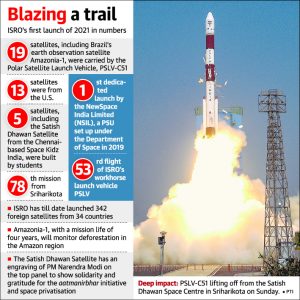01 Mar ISRO puts Brazil’s Amazonia-1, 18 other satellites into orbit
Context->ISRO commercial arm NewSpace India Ltd sent the satellite
About PSLV: Polar Satellite Launch Vehicle is the workhorse launch
vehicle of ISRO since 1994. It is the 1st operational launch vehicle and most reliable launch vheicle of india.. The PSLV is primarily developed to launch remote sensing satellites into sun synchronous orbits. PSLV is a 4-stage launch vehicle that uses an alternate combination of liquid and solid fueled rocket stages.
- 1st & 3rd stages are solid-fueled,
- 2nd & 4th stages are liquid fueled.
- Strap-on motors used in the solid stage i.e. 1st stage of PSLV in order to provide additional thrust to the rocket
- PSLV can deliver payloads of up to:
- 3,250kg to LEO (Low Earth Orbit)
- 1600 kg to SSO (Sun Synchronous orbit)
- 1400 kg to GTO (Geosynchronous Transfer Orbit)
- India’s Space History
- 980 India successfully launched its own Rohini-1 satellite Satellite Launch Vehicle (SLV) rocket from the Sriharikota
- 1992 The Indian-built INSAT-2 geostationary communications and meteorological satellite
- In 1993 A larger Polar Satellite Launch Vehicle (PSLV) debuted in September, but it was a failed attempt to attain orbit. Its individual elements were successful.
- In 2001 The first launch GSLV rocket was successful, it is mainly used to send satellite in the geostationary orbit.
- GSLV can boost a 2.5-ton satellite., it can also place large communications and weather satellites in high stationary orbits.
- In 2011 Nano-satellite weighing 3 kg developed by IIT Kanpur, and Nano-satellite weighing 10.9 kg developed by SRM University were sent by PSLV.





No Comments